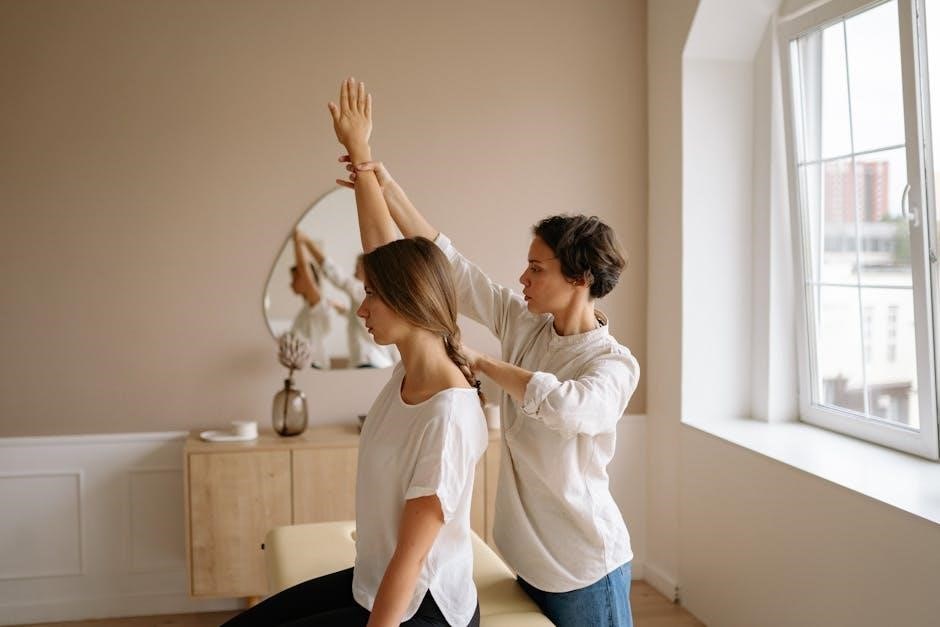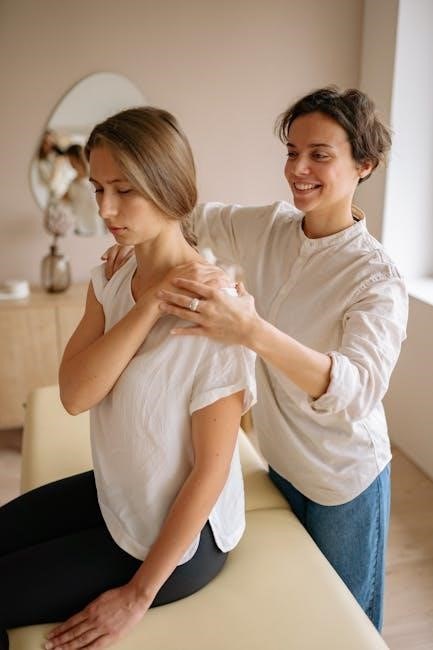Manual stretching is a practice involving targeted muscle elongation to enhance flexibility and movement․ It combines static and dynamic techniques, improving range of motion and reducing injury risk․
What is Manual Stretching?
Manual stretching involves physical techniques to elongate muscles, enhancing flexibility and range of motion; It combines static holds and dynamic movements, often assisted by a therapist or trainer, targeting specific areas like hamstrings and hips to improve mobility and reduce stiffness․
Importance of Manual Stretching
Manual stretching is crucial for preventing injuries, reducing muscle tension, and improving flexibility․ It enhances athletic performance by boosting range of motion and reducing stiffness․ Regular practice promotes better posture, alleviates chronic pain, and supports overall physical well-being․ Assisted by therapists or trainers, it ensures targeted and safe muscle elongation, making it a vital practice for both athletes and individuals seeking improved mobility and health․
Types of Manual Stretching
Manual stretching includes static and dynamic methods․ Static stretching involves holding stretched positions, while dynamic stretching uses controlled movements to improve flexibility and range of motion․
Static Stretching
Static stretching involves holding a muscle in a stretched position for 20-30 seconds․ It improves flexibility by lengthening muscle fibers and connective tissues, reducing stiffness and enhancing range of motion․ Often performed after workouts, it promotes recovery and relaxes muscles․ Proper technique is crucial to avoid injury, ensuring stretches are held comfortably without bouncing․ This method is ideal for cool-down routines, aiding in muscle relaxation and joint mobility improvement, making it a cornerstone of many stretching regimens․
Dynamic Stretching
Dynamic stretching involves active movements that mimic workout actions, preparing muscles for exercise․ It enhances blood flow, reduces stiffness, and activates muscle groups․ Unlike static stretching, it involves continuous motion, improving flexibility while maintaining muscle tension․ Often used in warm-ups, it helps prevent injuries and boosts athletic performance․ Dynamic stretches, such as leg swings and arm circles, are highly effective for pre-workout preparation, making them a preferred choice for athletes and fitness enthusiasts seeking optimal mobility and readiness․

Benefits of Manual Stretching
Manual stretching improves flexibility, reduces muscle tension, and enhances movement efficiency․ It also promotes circulation, lowers injury risk, and supports overall physical and mental well-being effectively․
Improved Flexibility
Manual stretching enhances flexibility by extending the length of muscles and tendons, allowing for greater range of motion․ Regular practice reduces stiffness, enabling smoother movements in daily activities and sports․ This increased flexibility also lowers the risk of strains and injuries, making it easier to maintain an active lifestyle․ Consistency is key to achieving and sustaining these benefits over time․
Injury Prevention
Manual stretching is a key method for injury prevention by strengthening muscles and increasing flexibility․ It reduces muscle tension and improves circulation, lowering the risk of strains and tears․ Regular stretching enhances joint stability, making it easier to maintain proper form during physical activities․ This proactive approach supports overall muscle health and aids in recovery, helping to prevent common injuries associated with tight or imbalanced muscles․
Enhanced Athletic Performance
Manual stretching significantly enhances athletic performance by improving flexibility, power, and speed․ Dynamic stretching prepares muscles for action, boosting range of motion and reducing stiffness․ It optimizes joint mobility, enabling athletes to perform complex movements with precision․ Regular stretching also accelerates recovery, allowing for consistent training intensity․ By incorporating both static and dynamic techniques, athletes can achieve peak performance, making manual stretching an essential component of their training regimen․
Target Areas for Manual Stretching

Key areas include hamstrings, hip flexors, shoulders, neck, lower back, and calves․ These regions benefit most from stretching to improve mobility and reduce muscle tension․
Hamstring and Hip Flexors
Hamstrings and hip flexors are crucial for movement and stability․ Stretching these areas improves posture, reduces tightness, and prevents injuries․ Techniques like seated forward folds and lunges can effectively target these muscles, enhancing flexibility and promoting better athletic performance․ Regular stretching of hamstrings and hip flexors is essential for maintaining optimal mobility and overall physical health․
Shoulders and Neck
The shoulders and neck are prone to tension due to poor posture and repetitive movements․ Manual stretching can alleviate stiffness and improve range of motion․ Techniques like shoulder rolls and gentle neck tilts are effective․ Regular stretching helps reduce the risk of injury and enhances overall comfort, making it easier to perform daily activities without discomfort or strain․
Lower Back and Calves
The lower back and calves are common areas for tension and tightness․ Manual stretching can help relieve stiffness and improve mobility․ Techniques like cat-cow stretches for the lower back and seated calf stretches are effective․ Regular stretching reduces muscle soreness, enhances posture, and lowers the risk of injuries․ It also promotes better circulation and relaxation, making it easier to engage in physical activities with comfort and ease․
Safety and Precautions
Always use proper techniques to avoid injury․ Avoid overstretching, as it can cause muscle damage․ Listen to your body and stay within a pain-free range during stretches․
Understanding Proper Technique
Mastering proper technique is crucial for effective and safe manual stretching․ Focus on controlled movements, avoiding bouncing or forcing beyond comfortable limits․ Ensure each stretch targets the intended muscle group without straining adjacent areas․ Breathe deeply and maintain a steady pace to maximize benefits and minimize injury risks․ Proper alignment and awareness of body positioning are key to achieving optimal results․
Avoiding Overstretching
Overstretching can lead to muscle strain or injury, undoing the benefits of manual stretching․ Listen to your body and stop if pain occurs․ Avoid excessive force or bouncing, as this can cause micro-tears․ Focus on gentle, sustained stretches within a comfortable range․ Pay attention to sensations; stretching should not cause sharp pain․ Prioritize controlled movements to protect muscles and joints, ensuring a safe and effective practice․

When to Perform Manual Stretching
Manual stretching is most effective when performed before and after workouts, as well as during physical therapy sessions to optimize flexibility and prevent muscle tension․
Before and After Workouts
Manual stretching is essential before workouts to prepare muscles for activity, improving flexibility and range of motion․ After workouts, it helps reduce muscle stiffness, enhances recovery, and prevents soreness․ Proper techniques, such as holding stretches for 20-30 seconds, maximize benefits while minimizing injury risks․ Incorporating both static and dynamic stretches ensures a well-rounded approach to maintaining muscle health and overall physical performance․ Consistency is key for long-term benefits․
As Part of Physical Therapy
Manual stretching is a cornerstone in physical therapy, aiding recovery by improving joint mobility and muscle flexibility․ It helps restore range of motion, reduces stiffness, and enhances tissue repair․ Therapists often combine stretching with strengthening exercises to address injuries or chronic pain․ Personalized stretching routines ensure targeted relief and long-term benefits, making it an essential tool for rehabilitation and overall physical well-being․ Regular practice promotes faster recovery and improved quality of life․
How to Perform Manual Stretching
Manual stretching involves targeted techniques to elongate muscles and improve flexibility․ Focus on proper posture, hold stretches for 20-30 seconds, and breathe deeply for optimal results; Always prioritize technique and safety to avoid injury, ensuring a smooth and effective stretching experience tailored to individual needs and goals․
Step-by-Step Techniques
Begin with a warm-up to prepare muscles․ Identify target areas and position the body correctly․ Apply gentle, sustained pressure to stretch the muscle, holding for 20-30 seconds․ Focus on controlled breathing to relax and deepen the stretch․ Gradually release the stretch and repeat as needed․ Always prioritize proper alignment and avoid bouncing or forcing beyond a comfortable range to ensure safety and effectiveness․
Using Props and Tools
Incorporate tools like resistance bands, foam rollers, or massage balls to enhance manual stretching․ Resistance bands provide gentle tension, while foam rollers release muscle tension․ Straps or towels can deepen stretches for hard-to-reach areas․ Props help maintain proper alignment, reduce strain, and increase flexibility․ They are especially useful for individuals with limited mobility or stiffness․ Always use tools safely and as guided to avoid injury and maximize the stretching benefits for overall muscle relaxation and improved range of motion․
Combining Manual Stretching with Other Exercises
Manual stretching pairs well with yoga, Pilates, and strength training․ These combinations enhance flexibility, improve posture, and boost overall physical performance, promoting a balanced fitness routine․
Incorporating Yoga and Pilates
Incorporating yoga and Pilates into a manual stretching routine enhances flexibility and strength․ These practices emphasize controlled movements and breathing, improving posture and reducing muscle tension․ Yoga focuses on holding poses to deepen stretches, while Pilates strengthens core muscles, providing stability․ Together, they create a holistic approach to fitness, combining the benefits of stretching with mindfulness and body awareness․
Pairing with Strength Training
Pairing manual stretching with strength training enhances muscle balance and overall performance․ Stretching improves flexibility, reducing the risk of injury during strength exercises․ It also promotes recovery by lengthening muscles post-workout․ When combined, both practices create a well-rounded fitness routine, ensuring muscles are strong, flexible, and resilient․ This synergy supports long-term athletic development and everyday mobility․

Common Misconceptions About Manual Stretching
Many misconceptions surround manual stretching, such as the belief that it only improves flexibility or that it is ineffective․ In reality, manual stretching encompasses various techniques that enhance mobility, prevent injuries, and promote overall well-being when performed correctly․
Busting Myths About Stretching
One common myth is that stretching only improves flexibility, but it also enhances circulation, posture, and muscle balance․ Another misconception is that stretching is a waste of time, when in fact, it prevents injuries and boosts athletic performance․ Many believe stretching should hurt, but gentle, controlled movements are more effective․ Debunking these myths helps individuals embrace stretching as a vital part of their fitness and wellness routine for long-term benefits․
Separating Fact from Fiction
Manual stretching is often misunderstood, with myths overshadowing its benefits․ A common fiction is that stretching is only for flexibility, but it also enhances circulation and posture․ Some believe stretching must hurt to be effective, yet gentle movements are more beneficial․ Another myth is that stretching is a waste of time, when it actually prevents injuries and improves performance․ Understanding these truths helps clarify the role of manual stretching in a balanced fitness routine․

Incorporating Manual Stretching into Daily Routine
Consistency is key to making manual stretching a habit․ Start with short sessions and gradually increase duration, ensuring it becomes a natural part of your daily schedule․
Creating a Stretching Schedule
Developing a consistent stretching schedule is essential for maximizing benefits․ Start by dedicating 10–15 minutes daily, focusing on major muscle groups like hamstrings, shoulders, and lower back․ Gradually increase the duration as flexibility improves․ Incorporate both static and dynamic stretches, tailoring the routine to your specific needs and goals․ Tracking progress in a journal can help maintain consistency and motivation over time․
Staying Consistent for Best Results
Consistency is key to achieving lasting benefits from manual stretching․ Aim to stretch 4–5 times weekly, focusing on muscle groups specific to your activities․ Even brief daily sessions can yield significant improvements over time․ Maintain a balanced approach, combining static and dynamic stretches, and adjust routines as flexibility and strength increase․ Regular practice fosters sustainable progress, ensuring enhanced mobility and reduced injury risk for long-term well-being․
Manual stretching is a powerful tool for enhancing flexibility, preventing injuries, and improving overall well-being․ Consistency and proper technique ensure lasting benefits, fostering a healthier, more active lifestyle․
Final Thoughts on Manual Stretching
Manual stretching is a simple yet profound practice that enhances flexibility, prevents injuries, and boosts overall well-being․ Regular practice, combined with proper technique, yields lasting benefits, encouraging a healthier, active lifestyle․
Encouragement for Regular Practice
Embrace manual stretching as a lifelong habit to nurture your body and mind․ Consistency is key to unlocking its full potential, fostering improved mobility and mental clarity․ By dedicating a few minutes daily, you invest in long-term wellness and resilience, empowering yourself to embrace life’s challenges with confidence and vitality․